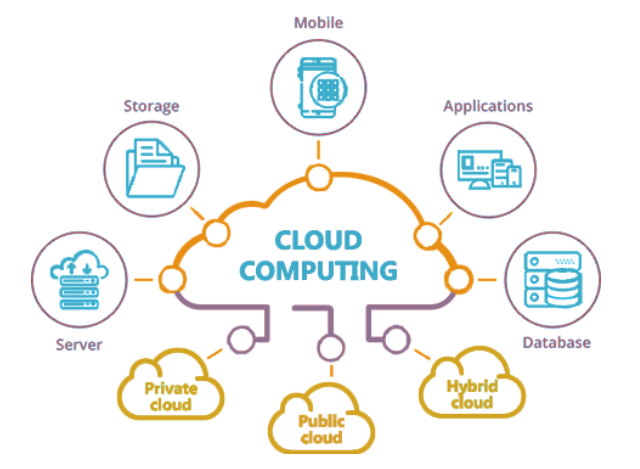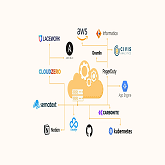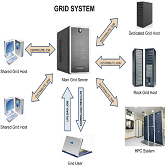Cloud Computing
Cloud computing is a rapidly growing technology that allows individuals and organizations to store, manage, and process data and applications over the internet. Instead of storing data on physical servers or personal devices, cloud computing allows users to access and use the data and applications via the internet, making it more accessible and cost-effective.
The concept of cloud computing is based on the idea of delivering computing resources, such as servers, storage, and applications, as a service over the internet. This service is provided by cloud service providers, such as Amazon Web Services (AWS), Microsoft Azure, and Google Cloud Platform (GCP). These providers offer a range of services, from basic storage and computing power to more advanced services such as machine learning and artificial intelligence.
One of the key benefits of cloud computing is its scalability. Users can easily scale up or down their computing resources as needed, without the need for costly investments in hardware or infrastructure. This allows organizations to quickly respond to changes in demand and easily adjust their computing resources accordingly.
Cloud computing also offers improved security and reliability. Cloud service providers invest heavily in security measures to protect user data, and they also have the expertise and resources to quickly respond to and mitigate any security breaches. Additionally, cloud computing allows for data and application redundancy, which ensures that data and applications are always available, even in the event of an outage.
Another advantage of cloud computing is its cost-effectiveness. Traditional IT infrastructure can be costly to set up and maintain, but with cloud computing, users only pay for the resources they use, making it more affordable for businesses of all sizes.
Cloud computing has several deployment models: Public, private, and hybrid. Public cloud services are owned and operated by third-party providers and are made available to the general public over the internet. Private cloud services are owned and operated by a single organization, and are designed to be used by that organization only. Hybrid cloud services are a combination of public and private clouds, allowing an organization to use both public and private cloud services as needed.
Cloud computing has revolutionized the way organizations do business. It allows them to be more agile, responsive, and cost-effective, while also improving security and reliability. As more and more organizations adopt cloud computing, it is likely that this technology will continue to shape the way we live and work.
In conclusion, cloud computing is a technology that allows individuals and organizations to store, manage, and process data and applications over the internet. It offers many benefits such as scalability, security, reliability, and cost-effectiveness. It has several deployment models such as public, private and hybrid clouds. Its increasing popularity is transforming the way organizations do business and it’s shaping the future of technology.
Advantages and Disadvantages of Cloud Computing.
Advantages of Cloud Computing:
- Cost-effective: Cloud computing can save companies a significant amount of money on IT infrastructure and maintenance. Instead of investing in expensive hardware and software, businesses can pay for the resources they need on a pay-as-you-go basis.
- Scalability: Cloud computing allows businesses to easily scale up or down their resources as needed, without having to invest in additional hardware.
- Accessibility: Cloud computing allows users to access their data and applications from any device with an internet connection, which makes it easy for remote workers and employees on the go.
- Backup and disaster recovery: Cloud providers often offer built-in backup and disaster recovery options, which can help protect businesses from data loss.
- Automation and Efficiency: Cloud computing enables automation, which makes it easier to manage and maintain IT resources.
Disadvantages of Cloud Computing:
- Security: Storing data and applications in the cloud can make them more vulnerable to hacking and cyber attacks.
- Dependence on internet connection: Users need a stable and fast internet connection to access cloud services, which can be a problem in areas with poor connectivity.
- Limited control: Businesses that use cloud computing may have less control over their IT resources and may be at the mercy of the cloud provider’s policies and procedures.
- Compliance: Some industries have strict regulations that may not be met by cloud providers, making it difficult for businesses to use cloud services.
- Downtime: Cloud services can be subject to downtime, which can disrupt business operations.
Overall, cloud computing offers many benefits, but it also comes with certain risks and challenges. Businesses should weigh the advantages and disadvantages carefully before deciding to move their operations to the cloud.
What are the main types of cloud computing?
There are several different types of cloud computing, each with its own set of benefits and drawbacks. The main types of cloud computing are:
- Infrastructure as a Service (IaaS): This type of cloud computing provides users with virtualized computing resources, such as servers, storage, and networking. Users can access and manage these resources as needed, and only pay for what they use. Examples of IaaS providers include Amazon Web Services (AWS), Microsoft Azure, and Google Cloud Platform (GCP).
- Platform as a Service (PaaS): This type of cloud computing provides users with a platform for building and deploying applications. PaaS providers typically handle the underlying infrastructure and give users tools for developing and deploying applications. Examples of PaaS providers include Heroku, Google App Engine, and AWS Elastic Beanstalk.
- Software as a Service (SaaS): This type of cloud computing provides users with access to software applications over the internet. Users can access these applications from any device with an internet connection, and they are typically charged on a subscription basis. Examples of SaaS providers include Salesforce, Microsoft Office 365, and Google Docs.
- Function as a Service (FaaS): This type of cloud computing allows developers to execute code without provisioning or managing servers. This allows developers to focus on writing code, while the cloud provider handles the underlying infrastructure. AWS Lambda and Azure Functions are examples of FaaS.
- Desktop as a Service (DaaS): This type of cloud computing provides users with remote access to a virtual desktop, which can be accessed from any device with an internet connection. This allows users to run desktop applications and access files from anywhere. Examples of DaaS providers include Amazon WorkSpaces and Citrix Virtual Desktops.
Each type of cloud computing has its own set of advantages and disadvantages, and the best choice will depend on the specific needs of the organization or individual using it.
What Is Cloud Computing PDF Download
If you want to download Cloud Computing PDF Just click on the button bellow.
Thanks for visiting Idreeselahi.in, Hope this article regarding Cloud Computing was helpful. If you have any kind of query or any other problem please feel free to contact us. https://idreeselahi.in/contact-us.




One thought on “What is Cloud Computing? Pros and Cons of cloud computing – 2023”